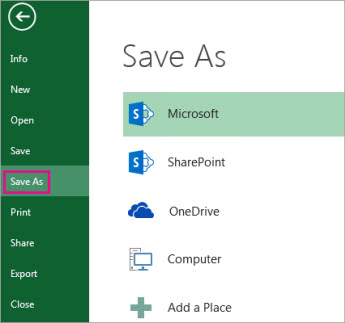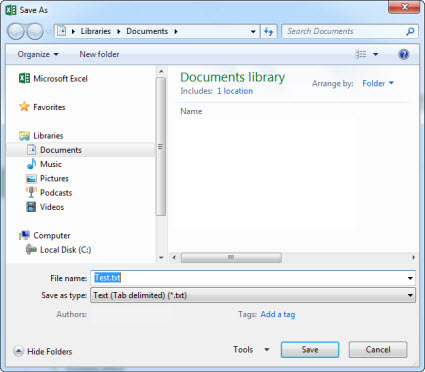
Most of the time, you’ll probably want to save your workbooks in the current file format (.xlsx). But sometimes, you might need to save a workbook in another file format, like the file format of an earlier version of Excel, a text file, or a PDF or XPS file. Just keep in mind that whenever you save a workbook in another file format, some of its formatting, data, and features might not be saved.
For a list of file formats (also called file types) you can (and can’t) open or save in Excel 2013, see File formats that are supported in Excel at the end of this article.


Under Places, pick the place where you want to save the workbook. For example, pick OneDrive to save it to your Web location or Computer to save it in a local folder like your Documents.

In the Save As dialog box, navigate to the location you want.
Note: The file formats you’ll see vary, depending on what type of sheet is active in your workbook (a worksheet, chart sheet, or other type of sheet).
Convert an Excel 97-2003 workbook to the current file formatIf you opened an Excel 97-2003 workbook but don’t need to keep it in that file format, simply convert it to the current file format (.xlsx).

In Excel 2013, you can open and save files in the following file formats:
Excel file formats
Description
The default XML-based file format for Excel 2007-2013. Cannot store Microsoft Visual Basic for Applications (VBA) macro code or Microsoft Office Excel 4.0 macro sheets (.xlm).
Strict Open XML Spreadsheet
An ISO strict version of the Excel Workbook file format (.xlsx).
Excel Workbook (code)
The XML-based and macro-enabled file format for Excel 2007-2013. Stores VBA macro code or Excel 4.0 macro sheets (.xlm).
Excel Binary Workbook
The binary file format (BIFF12) for Excel 2007-2013.
The default file format for an Excel template for Excel 2007-2013. Cannot store VBA macro code or Excel 4.0 macro sheets (.xlm).
The macro-enabled file format for an Excel template in Excel 2007-2013. Stores VBA macro code or Excel 4.0 macro sheets (.xlm).
Excel 97- Excel 2003 Workbook
The Excel 97 - Excel 2003 Binary file format (BIFF8).
Excel 97- Excel 2003 Template
The Excel 97 - Excel 2003 Binary file format (BIFF8) for an Excel template.
Microsoft Excel 5.0/95 Workbook
The Excel 5.0/95 Binary file format (BIFF5).
XML Spreadsheet 2003
XML Spreadsheet 2003 file format (XMLSS).
XML Data format.
The XML-based and macro-enabled Add-In format for Excel 2007-2013. An Add-In is a supplemental program that is designed to run additional code. Supports the use of VBA projects and Excel 4.0 macro sheets (.xlm).
Excel 97-2003 Add-In
The Excel 97-2003 Add-In, a supplemental program that is designed to run additional code. Supports the use of VBA projects.
Excel 4.0 Workbook
An Excel 4.0 file format that saves only worksheets, chart sheets, and macro sheets. You can open a workbook in this file format in Excel 2013, but you cannot save an Excel file to this file format.
Text file formats
Description
Formatted Text (Space-delimited)
Lotus space-delimited format. Saves only the active sheet.
Saves a workbook as a tab-delimited text file for use on another Microsoft Windows operating system, and ensures that tab characters, line breaks, and other characters are interpreted correctly. Saves only the active sheet.
Saves a workbook as a tab-delimited text file for use on the Macintosh operating system, and ensures that tab characters, line breaks, and other characters are interpreted correctly. Saves only the active sheet.
Saves a workbook as a tab-delimited text file for use on the MS-DOS operating system, and ensures that tab characters, line breaks, and other characters are interpreted correctly. Saves only the active sheet.
Saves a workbook as Unicode text, a character encoding standard that was developed by the Unicode Consortium.
CSV (comma delimited)
Saves a workbook as a comma-delimited text file for use on another Windows operating system, and ensures that tab characters, line breaks, and other characters are interpreted correctly. Saves only the active sheet.
Saves a workbook as a comma-delimited text file for use on the Macintosh operating system, and ensures that tab characters, line breaks, and other characters are interpreted correctly. Saves only the active sheet.
Saves a workbook as a comma-delimited text file for use on the MS-DOS operating system, and ensures that tab characters, line breaks, and other characters are interpreted correctly. Saves only the active sheet.
Data Interchange Format. Saves only the active sheet.
Symbolic Link Format. Saves only the active sheet.
Note: If you save a workbook in any text format, all formatting is lost.
Other file formats
Description
dBase III and IV. You can open these files formats in Excel, but you cannot save an Excel file to dBase format.
OpenDocument Spreadsheet. You can save Excel 2010 files so they can be opened in spreadsheet applications that use the OpenDocument Spreadsheet format, such as Google Docs and OpenOffice.org Calc. You can also open spreadsheets in the .ods format in Excel 2010. Formatting might be lost when saving and opening .ods files.
Portable Document Format (PDF). This file format preserves document formatting and enables file sharing. When the PDF format file is viewed online or printed, it retains the format that you intended. Data in the file cannot be easily changed. The PDF format is also useful for documents that will be reproduced by using commercial printing methods.
XML Paper Specification (XPS). This file format preserves document formatting and enables file sharing. When the XPS file is viewed online or printed, it retains exactly the format that you intended, and the data in the file cannot be easily changed.
File formats that use the clipboard
If you copied data to the clipboard in one of the following file formats, you can paste it into Excel using the Paste or Paste Special command (Home > Clipboard > Paste).
Clipboard type identifiers
Pictures in Windows Metafile Format (WMF) or Windows Enhanced Metafile Format (EMF).
Note: If you copy a Windows metafile picture from another program, Excel pastes the picture as an enhanced metafile.
Pictures stored in Bitmap format (BMP).
Microsoft Excel file formats
Binary file formats for Excel versions 5.0/95 (BIFF5), Excel 97-2003 (BIFF8), and Excel 2013 (BIFF12).
Symbolic Link Format.
Data Interchange Format.
Tab-separated text format.
Comma-separated values format.
Formatted text (Space-delimited)
Rich Text Format (RTF). Only from Excel.
.gif, .jpg, .doc, .xls, or .bmp
Microsoft Excel objects, objects from properly registered programs that support OLE 2.0 (OwnerLink), and Picture or another presentation format.
.gif, .jpg, .doc, .xls, or .bmp
OwnerLink, ObjectLink, Link, Picture, or other format.
Office drawing object
Office drawing object format or Picture (Windows enhanced metafile format, EMF).
Display Text, OEM Text.
Single File Web Page
Single File Web Page (MHT or MHTML). This file format integrates inline graphics, applets, linked documents, and other supporting items referenced in the document.
Hypertext Markup Language (HTML).
Note: When you copy text from another program, Excel pastes the text in HTML format, regardless of the format of the original text.
File formats that are not supported in Excel 2013
The following file formats are no longer supported, so you can’t open or save files in these file formats.
To work with your workbook data in a program that isn’t supported anymore, try the following:
Clipboard type identifiers
Excel 2.0, 3.0, and 2.x file formats
WK1, FMT, WK2, WK3, FM3, WK4
.wk1, .wk2, .wk3, .wk4, .wks
Lotus 1-2-3 file formats (all versions)
Microsoft Works file format (all versions)
DBASE II file format
Quattro Pro for MS-DOS file format
Quattro Pro 5.0 and 7.0 for Windows.



Explore subscription benefits, browse training courses, learn how to secure your device, and more.




Communities help you ask and answer questions, give feedback, and hear from experts with rich knowledge.